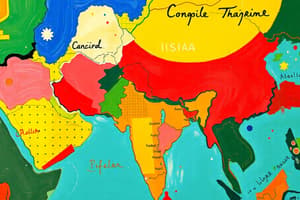Podcast
Questions and Answers
What was a primary reason for the demand for English knowledge among Indian clerks and officials?
What was a primary reason for the demand for English knowledge among Indian clerks and officials?
- To help in translating ancient texts.
- To gain higher social status.
- To secure jobs in administration. (correct)
- To serve as interpreters for travelers.
What did the missionaries believe was the purpose of imparting Western education to Indians?
What did the missionaries believe was the purpose of imparting Western education to Indians?
- To provide vocational training.
- To promote literacy without cultural change.
- To preserve local customs.
- To challenge the religious beliefs of Hinduism. (correct)
Which of the following was a viewpoint of Charles Grant regarding English education in India?
Which of the following was a viewpoint of Charles Grant regarding English education in India?
- It was unnecessary for the empire's stability.
- It would corrupt Indian values.
- It would help assimilate Indians to Western culture. (correct)
- It should be limited to elite classes only.
What were the Orientalists' concerns regarding English education in India?
What were the Orientalists' concerns regarding English education in India?
What was the general trend in Indian education noted after 1824?
What was the general trend in Indian education noted after 1824?
Which of the following figures is noted for having a reformist approach to education in Bengal?
Which of the following figures is noted for having a reformist approach to education in Bengal?
What was the goal expressed by the imperialists regarding the spread of English among Indians?
What was the goal expressed by the imperialists regarding the spread of English among Indians?
How did most Indian intellectuals perceive the rise of English education?
How did most Indian intellectuals perceive the rise of English education?
What strategy did mission schools adopt in the South before the end of the eighteenth century?
What strategy did mission schools adopt in the South before the end of the eighteenth century?
What did H.H. Wilson argue about the effectiveness of English language education?
What did H.H. Wilson argue about the effectiveness of English language education?
How did the Indian renaissance compare to the European renaissance?
How did the Indian renaissance compare to the European renaissance?
What two perspectives did India embrace during her awakening?
What two perspectives did India embrace during her awakening?
Which East India Company official founded the Bengal Asiatic Society?
Which East India Company official founded the Bengal Asiatic Society?
What was the initial British policy towards education in India after the East India Company took control?
What was the initial British policy towards education in India after the East India Company took control?
Which languages were revived for study among Indians as part of the new educational policies?
Which languages were revived for study among Indians as part of the new educational policies?
What was a practical consideration that influenced British education policy in India?
What was a practical consideration that influenced British education policy in India?
What key role did early officials of the East India Company play during the renaissance?
What key role did early officials of the East India Company play during the renaissance?
What change in perspective occurred by the turn of the century among British officials regarding education?
What change in perspective occurred by the turn of the century among British officials regarding education?
Which official is noted for authoring a significant work relating to Hindu law?
Which official is noted for authoring a significant work relating to Hindu law?
What approach to culture did the early British officials adopt?
What approach to culture did the early British officials adopt?
What was the primary aim of the East India Company when it was initially granted its charter?
What was the primary aim of the East India Company when it was initially granted its charter?
What crucial event allowed the British East India Company to gain significant power in Bengal?
What crucial event allowed the British East India Company to gain significant power in Bengal?
What does the phrase 'shaking the Indian 'Pagoda tree' of its treasures' symbolize?
What does the phrase 'shaking the Indian 'Pagoda tree' of its treasures' symbolize?
What is the main purpose of the author's use of Kipling's words in the excerpt?
What is the main purpose of the author's use of Kipling's words in the excerpt?
Which of the following is NOT mentioned as a contributing factor to the modernization process in India during the nineteenth century?
Which of the following is NOT mentioned as a contributing factor to the modernization process in India during the nineteenth century?
According to the excerpt, how did the British involvement in India evolve over time?
According to the excerpt, how did the British involvement in India evolve over time?
What is the main idea of the excerpt?
What is the main idea of the excerpt?
Which of the following is NOT a valid interpretation of the phrase 'manifest destiny' as used in the context of the excerpt?
Which of the following is NOT a valid interpretation of the phrase 'manifest destiny' as used in the context of the excerpt?
What significance can be attributed to the mention of Sigelm's pilgrimage to India in the 9th century?
What significance can be attributed to the mention of Sigelm's pilgrimage to India in the 9th century?
What can be inferred from Clive's statement, 'I stand astonished at my own moderation'?
What can be inferred from Clive's statement, 'I stand astonished at my own moderation'?
Flashcards
First Englishman in India
First Englishman in India
Sigelm was the first Englishman to visit India, sent by King Alfred in A.D. 883.
Vasco da Gama
Vasco da Gama
He discovered the sea-route to India in 1498, opening trade for Europeans.
East India Company
East India Company
It was granted its first charter by Queen Elizabeth I in 1600 for trade.
Mughal Empire decline
Mughal Empire decline
Signup and view all the flashcards
Battle of Plassey
Battle of Plassey
Signup and view all the flashcards
Pagoda tree
Pagoda tree
Signup and view all the flashcards
Indian English literature rise
Indian English literature rise
Signup and view all the flashcards
King Henry VIII's petition
King Henry VIII's petition
Signup and view all the flashcards
Colonial legacy
Colonial legacy
Signup and view all the flashcards
Rudyard Kipling's quote
Rudyard Kipling's quote
Signup and view all the flashcards
Indian Renaissance
Indian Renaissance
Signup and view all the flashcards
Two-fold awakening
Two-fold awakening
Signup and view all the flashcards
East India Company Officials
East India Company Officials
Signup and view all the flashcards
Sir William Jones
Sir William Jones
Signup and view all the flashcards
Cultural Rediscovery
Cultural Rediscovery
Signup and view all the flashcards
Education Policy Evolution
Education Policy Evolution
Signup and view all the flashcards
Calcutta Madarasa
Calcutta Madarasa
Signup and view all the flashcards
Sanskrit College at Benaras
Sanskrit College at Benaras
Signup and view all the flashcards
Orientalists
Orientalists
Signup and view all the flashcards
Shift in Educational Focus
Shift in Educational Focus
Signup and view all the flashcards
Need for Clerks
Need for Clerks
Signup and view all the flashcards
Evangelical Movement
Evangelical Movement
Signup and view all the flashcards
Mission Schools
Mission Schools
Signup and view all the flashcards
Charles Grant's Argument
Charles Grant's Argument
Signup and view all the flashcards
Orientalists' Objection
Orientalists' Objection
Signup and view all the flashcards
H.H. Wilson's View
H.H. Wilson's View
Signup and view all the flashcards
Home Office Despatches
Home Office Despatches
Signup and view all the flashcards
Governors' Influence
Governors' Influence
Signup and view all the flashcards
Intellectual Consensus
Intellectual Consensus
Signup and view all the flashcards
Western Culture Assimilation
Western Culture Assimilation
Signup and view all the flashcards
Study Notes
Chapter 2 - The Pagoda Tree: From the Beginnings to 1857
- The British connection with India significantly began in the 17th century, though English presence was documented as early as AD 883.
- Vasco da Gama's discovery of the sea route to India in 1498 brought Portuguese and Dutch traders earlier than the British. British interest, however, remained nascent in the mid-16th century.
- A petition to King Henry VIII in 1511 expressed desire for exploration of the Indies and securing its treasure.
- The East India Company, chartered by Queen Elizabeth I in the late 16th century, marked a new era in East-West relations.
- The Company's initial goal was commerce, but the vacuum left by the Mughal Empire's disintegration in the late 18th century led them to take control of India.
Indian Renaissance and the Rise of English Literature
- The Indian renaissance, according to Sri Aurobindo, was less a copy of European movements but an expression of self-renewal. It aimed at reshaping Indian society.
- The period was marked by a dual focus: looking internally at India’s past and engaging with the West. This dual approach helped in the rediscovery of India's past.
- British officials of the Company who were scholars of Indian culture played a role in this rediscovery process.
British Education Policy in India
- Early British policies on Indian education oscillated between two approaches: either ignoring or advocating for the spread of Western education.
- Initial lack of an official government education policy, coupled with the need for Indian clerks, led to the establishment of institutions teaching Sanskrit and Persian.
- The 1780s and 1790s saw the rise of the Orientalist school of thought, which advocated the importance of Indian languages and cultures in education. This led to the establishment of the Calcutta Madarasa and Sanskrit College.
- However, by the 1820s, British policies began increasingly favoring the spread of Western education in India.
- Missionary efforts played a significant role in introducing English schools in India.
The Emergence of Indian English Literature
- Indian individuals like Raja Rammohun Roy advocated for the spread of English education.
- They argued that English education could integrate Indians better and support the progress of Indian societies.
- Early works in English by Indians predominantly consist of translations and documents rather than original creative works.
- The establishment of three Indian universities in 1857 marked a key turning point in the development of Indian English writing.
Studying That Suits You
Use AI to generate personalized quizzes and flashcards to suit your learning preferences.




